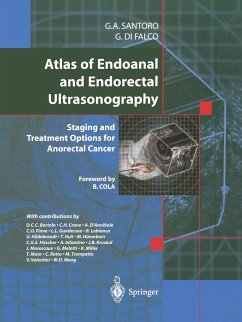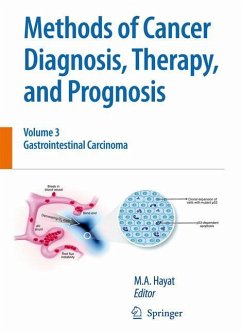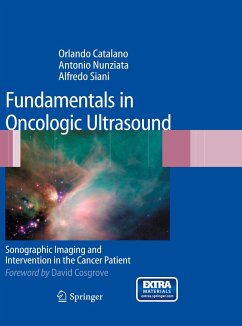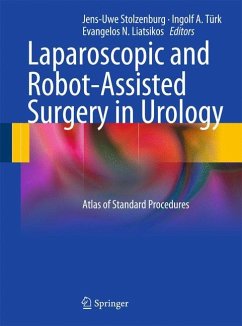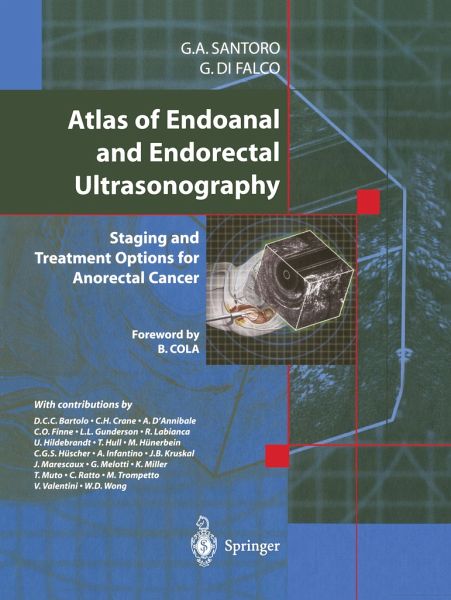
Atlas of Endoanal and Endorectal Ultrasonography
Staging and Treatment Options for Anorectal Cancer
Mitarbeit: Cola, B.
Versandkostenfrei!
Versandfertig in 6-10 Tagen
174,99 €
inkl. MwSt.

PAYBACK Punkte
87 °P sammeln!
The introduction of two-dimensional and three-dimensional endorectal ultrasonography has increased the diagnostic accuracy in staging and follow-up of anal and rectal tumors. As a consequence of the recent and continuous developments in diagnostic imaging, major advances have also been made in the field of surgery, with the advent of laparoscopic, robotic and microscopic transanal interventional techniques, and in oncology with the utilization of neoadjuvant chemotherapy and intraoperative radiotherapy. Written by internationally renowned experts in the field of endoanal and endorectal ultrasonography, this atlas provides a complete overview of different neoplasia and will be a useful companion in everyday clinical practice.
The chapters are divided into three main parts illustrating: - the basic principles of ultrasonography, techniques of endoanal and endorectal ultrasonography, and surgical and endosonographic anatomy of the anal canal and rectum; - the ultrasonographic staging of anorectal tumors with numerous endoscopic, radiologic, operative, and histologic illustrations; - surgical and oncologic therapeutic strategies.
Considering the wide range of topics covered, the volume will be of interest to surgeons, coloproctologists, radiologists, gastroenterologists, oncologists and radiotherapists.
The chapters are divided into three main parts illustrating: - the basic principles of ultrasonography, techniques of endoanal and endorectal ultrasonography, and surgical and endosonographic anatomy of the anal canal and rectum; - the ultrasonographic staging of anorectal tumors with numerous endoscopic, radiologic, operative, and histologic illustrations; - surgical and oncologic therapeutic strategies.
Considering the wide range of topics covered, the volume will be of interest to surgeons, coloproctologists, radiologists, gastroenterologists, oncologists and radiotherapists.
Endoanal and endorectal ultrasound represents considerable progress in the field of anorectal imaging. Its importance in the staging of rectal and anal cancer, in identifying perianasto motic neoplastic recurrences, in defining acute and chronic suppurative disease and in assessing sphincteral anatomical integrity, is now a confirmed reality. The evidence provided by endoanal and endorectal ultrasonography guides the colorectal surgeon in his choice among the various therapeutic approaches and helps in assessing the effects of the treatments applied. The great flexibility and high degree of reliability make this exploratory method an indispensable tool at all stages of the clinical course in the majority of patients with anorectal problems, including the fundamental follow-up stage. The publication of this excellent volume on intraanal and intrarectal ultrasonog raphy is therefore to be appreciated, especially since it is in the form of an atlas. As we are dealing with imaging, it is particularly appropriate that it is the images that tell the story. Like all important things, this volume does not come out of nothing. It is the result of many years of skilled work by Drs. G.A. Santoro and G. Di Falco and is based on the experience of internationally renowned professional experts. The ten sections of the atlas begin with general information on ultrasonography, gradually progressing to the technical problems of the method and the aspects rela tive to anorectal tumors.This last section leads to a review of traditional and mod ern therapeutic possibilities.



